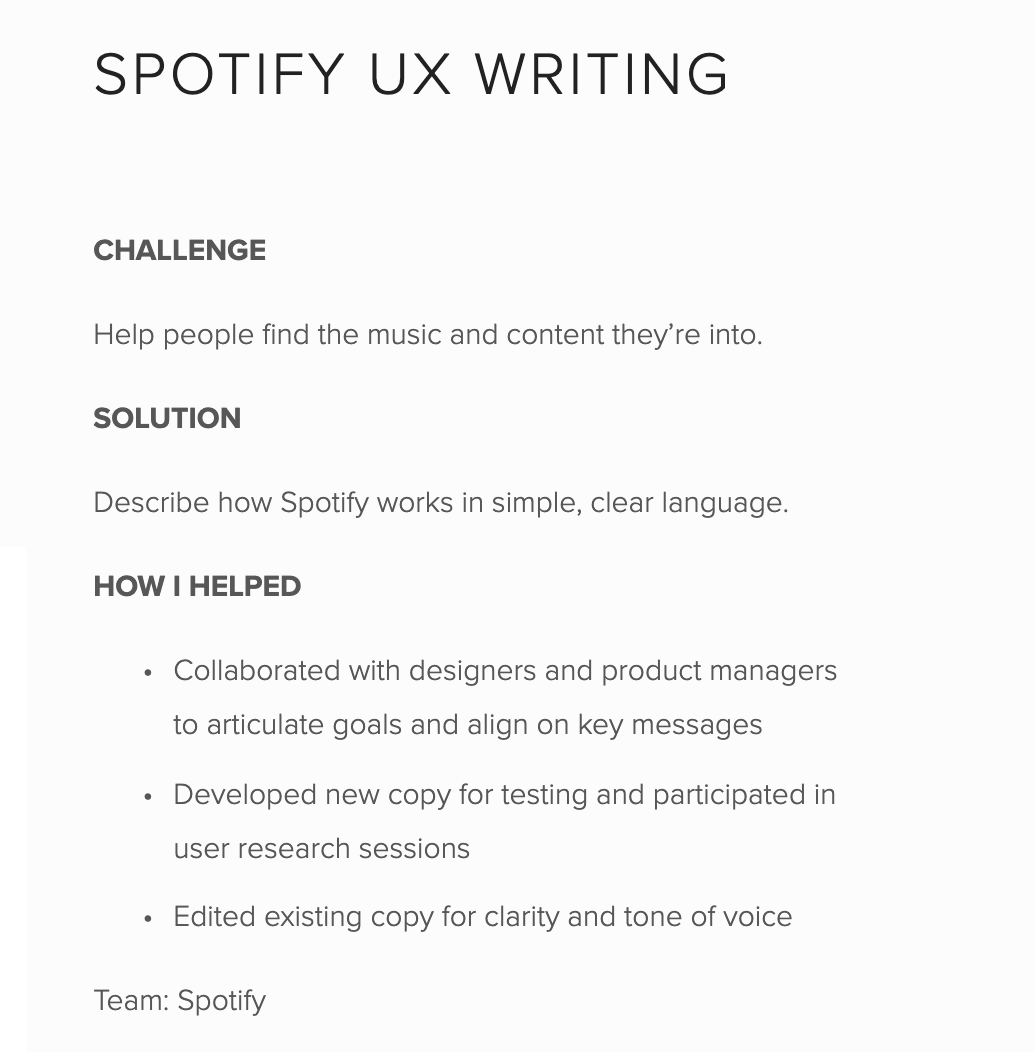How to create a UX writing portfolio
Let’s be honest. Creating a portfolio is a serious pain in the butt.
And it matters little whether you are a seasoned professional or a newbie just starting out, building your portfolio is still a strenuous exercise.
So, after going through the ups and downs of creating a portfolio (with no less than three different portfolio websites having the unfinished remains of my abandoned portfolio projects), I’m here to share what I learned along the way.
And hopefully, it will make your process as simple and less painful as possible.
What should go into your UX writing portfolio?
Before you bother about domain names and what site to publish your portfolio on, let’s focus on the content of your portfolio. Like every product, good designs are great but it’s the content people are interested in.
A. Case studies
(Structure, structure, structure!)
All good UX writing portfolios have one thing in common: a clear structure. Each case study can often be broken into three parts: Background, Contribution, and Solution.
In this portfolio, Marina Posniak outlines the relevant information before delving deeper into the project.
The background offers readers a glimpse into what the product is about, who the users are, their goals, and the problem faced.
The contribution is where you talk about your input as a UX writer. ‘What roles did you take on? What were the deliverables? How long did the project last?.’ Keep it concise and clear.
The solution focuses on the deliverables and the impact of your work (where data is available).
🔎 Related: My closet: a UX case study
Moving past the outline
By providing information about your user’s goals, problem, and the solution, you go beyond just showing copy edits into the heart of user experience writing itself — user advocacy.
It lets people know that the customer is at the forefront of your writing process and that your decisions are in-line with improving their experience.
Tip 💡: Don’t shy away from sharing the user journey in your case studies.
The user journey is a big part of the end-to-end design process. The hiring manager wants to know you have a holistic understanding of the product development process from validation (user research) to building solutions (UX/UI) to validating solutions (analytics) — Vanschneider
B. Writing samples
Don’t forget the context ✍️
When showcasing your writing samples like error messages, notifications, and the likes, it is insightful to provide context to help people understand why your edits were necessary.
Tell how customers arrive at that point, the effect the copy had on their journey, and how you helped improve their experience. Try to make it as concise as possible.
🔎 Related: Why I talk about human-centred approaches
C. Personal information
Your portfolio, your personality 🤘
Treat your portfolio as a product. What kind of experience would your readers have? Is there consistency in your copy and voice? How do you want to sound?
Overall, your portfolio gives hiring managers a sense of your personality. So make good use of your language style and voice, especially on your ‘About me’ page.
Lastly, never fail to proofread your portfolio multiple times. You don’t want hiring managers to find spelling and grammar errors in your portfolio. Trust me.
Additional UX writing portfolio tips
Use design terms. It shows that you have some knowledge of the design process and that you can effectively communicate with other members of a design team. Try not to overdo it though, use them wisely.
Show your ability to be a team player. Did you collaborate with anyone on your projects? State it clearly.
Share the thought process behind your works. ‘How did you arrive at your solution?’ ‘What questions did you have along the way?’ ‘What is your writing process like?’
Indicate the tools you are familiar with. For example, Figma, Miro, InVision, etc
Make your resume available for download — if you’re comfortable with it.
Finding the right site to publish your UX writing portfolio
There are many website builders available and it has become a hassle selecting one to use. So here are five good website-building tools for your portfolio.
1. Squarespace ($12.00 monthly)
It is one of the most popular sites for building a portfolio. It comes with a 14-day free trial to set up your portfolio and offers highly customizable templates among other features.
2. Carbonmade ($9.00 monthly)
I found this to be one of the easier sites to create a portfolio on. Plus, you can work on the portfolio for as long as you wish without paying. You only pay when you’re ready to make it public.
It also offers exciting features and has a global talent pool.
3. Notion (Free or Personal pro — $4.00 monthly)
Notion is a fantastic tool that not only serves as a workspace for individuals and teams but also serves as a platform for building portfolios and resumes. You can either use it for free or upgrade it for extra benefits. Here’s how to build your portfolio step-by-step with Notion.
For inspiration, check out this portfolio by Jodie Loi built with Notion.
4. Figma (Free)
If you’re good with Figma, let your creativity flow and design your portfolio without the limitations that come with website-builders. Just share your prototype link whenever your portfolio is needed.
Feeling up to the challenge? There’s a Figma community template to help you get started.
5. UXfolio ($9.00 monthly)
Though relatively new, this portfolio-building software is rapidly gaining popularity among UX folks. Its features are tailored to help you showcase your design process in case studies. Simply put, it was created with UXers in mind.
Honorary mention: Google slides. Though sometimes overlooked, it’s a powerful tool to build your portfolio on — and it’s free.
Publicise your work
Lastly, don’t be afraid to link your portfolio to your LinkedIn profile or other social media platforms you use. While it’s natural to feel your work is not good enough, you’ve put a lot of effort into it so give yourself some well-deserved credit.
Plus, with publicity comes a greater reach. And you never know who’ll come across it and be impressed.
Good luck!
=====
Now you’ve read this, you might also be interested in





